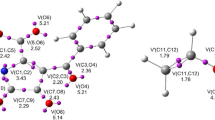Abstract
A systematic study of the mechanism of phenylselenoetherification of a naturally occurring alcohol linalool with PhSe+ was performed at the B3LYP/6-311+G(d,p) level of theory, in conjunction with the CPCM solvation model. The syn and anti reaction pathways were examined in the absence and presence of some Lewis bases (quinoline, piperidine, pyridine, and triethylamine) as catalysts. It was found that the reaction occurs via the phenylseleniranium intermediate, which further suffers a nucleophilic attack of the oxygen to two olefinic carbon atoms. This intramolecular cyclization yields 5-ethenyl-5-methyl-2-[2-(phenylseleno)-prop-2-yl]tetrahydrofuran as the major product and 6-ethenyl-2,2,6-trimethyl-3-phenylselenotetrahydropyran as the minor product. Lewis bases facilitate the reaction by strong hydrogen bonds between the alcoholic hydrogen and nitrogen of an additive moiety, and they stabilize the product complexes. Since the formation of the tetrahydrofuran derivative requires higher activation energy, but is thermodynamically more stable than the tetrahydropyran, it was concluded that the phenylselenoetherification reaction of linalool is thermodynamically controlled.
Graphical Abstract






Similar content being viewed by others
References
Nicolaou KC (2003) Tetrahedron 59:6683
Angle SR, White SL (2000) Tetrahedron Lett 41:8059
Harmange JC, Figadere B (1993) Tetrahedron Asymmetry 4:1711
Wesley JW (ed) (1982) Polyether antibiotics naturally occurring ionophores, vol I, II. Marcel Dekker, New York
Huczyński A, Janczak J, Stefańska J, Antoszczak M, Brzezinski B (2012) Bioorg Med Chem Lett 22:4697
Huczyński A, Rutkowski J, Borowicz I, Wietrzyk J, Maj E, Brzezinski B (2013) Bioorg Med Chem Lett 23:5053
Miura K, Okajima S, Hondo T, Nakagawa T, Takahashi T, Hosomi A (2000) J Am Chem Soc 122:11348
Postema MHD (1992) Tetrahedron 48:8545
Paramathevar N, Namakkal GR (2010) Tetrahedron 66:599
Gálvez E, Sau M, Romea P, Urpí F, Font-Bardia M (2013) Tetrahedron Lett 54:1467
Sakabe N, Goto T, Hirata Y (1977) Tetrahedron 33:3077
Niwa M, Endo T, Ogiso S, Furukava H, Yamamura S (1981) Chem Lett 10:1285
Rebuffat S, Davoust D, Molho L, Molho D (1980) Phytochemistry 19:427
Mulheirn LJ, Beechey RB, Leworthy DP, Osselton MD (1974) J Chem Soc Chem Commun 21:874
Kruger GJ, Steyn PS, Vleffar R, Rabie CJ (1979) J Chem Soc Chem Commun 10:441
Mugesh G, Du Mont WW, Sies H (2001) Chem Rev 101:2125
Tiecco M (2000) Electrophilic selenium, selenocyclization. In: Wirth T (ed) Topics in current chemistry: organoselenium chemistry, vol 208. Springer, Heidelberg, p 7
Petragnani N, Stefani HA, Valduga CJ (2001) Tetrahedron 57:1411
Ranganathan S, Muraleedharan KM, Vaish NK, Jayaraman N (2004) Tetrahedron 60:5273
Wirth T (ed) (2011) Electrophilic selenium reagents in organoselenium chemistry. Wiley-VCH, Weinheim, p 1
Konstantinović S, Bugarčić Z, Milosavljević S, Schroth G, Mihailović MLJ (1995) Liebigs Ann Chem 34:354
Mojsilović BM, Bugarčić ZM (2001) Heteroatom Chem 12:475
Bugarčić ZM, Dunkić JD, Mojsilović BM (2004) Heteroatom Chem 15:468
Bugarčić ZM, Mojsilović BM (2004) Heteroatom Chem 15:146
Bugarčić ZM, Mojsilovic BM, Divac VM (2007) J Mol Cat A Chem 272:288
Divac VM, Rvović MD, Bugarčić ZM (2008) Monatsh Chem 139:1373
Bugarčić ZM, Petrović BV, Rvović MD (2008) J Mol Cat A Chem 287:171
Divac VM, Puchta R, Bugarčić ZM (2012) J Phys Chem A 116:7783
Rvović MD, Divac VM, Puchta R, Bugarčić ZM (2011) J Mol Mod 17:1251
Sylvestre M, Longtin APA, Legault J (2007) Nat Prod Commun 2:273
Yu JQ, Lei JC, Zhang XQ, Yu HD, Tian DZ, Liao ZX, Zou GL (2011) Food Chem 126:1593
Nibret E, Wink M (2010) Phytomedicine 17:911
Serbetci T, Demirci B, Guzel CB, Kultur S, Erguven M, Baser KHC (2010) Nat Prod Commun 5:1369
Rvović MD, Divac VM, Janković NŽ, Bugarčić ZM (2013) Monatsh Chem 144:1227
Divac VM, Rvović MD, Bugarčić ZM (2013) React Kinet Mech Catal 110:309
Frisch MJ, Trucks GW, Schlegel HB, Scuseria GE, Robb MA, Cheeseman JR, Scalmani G, Barone V, Mennucci B, Petersson GA, Nakatsuji H, Caricato M, Li X, Hratchian HP, Izmaylov AF, Bloino J, Zheng G, Sonnenberg JL, Hada M, Ehara M, Toyota K, Fukuda R, Hasegawa J, Ishida M, Nakajima T, Honda Y, Kitao O, Nakai H, Vreven T, Montgomery JA Jr, Peralta JE, Ogliaro F, Bearpark M, Heyd JJ, Brothers E, Kudin KN, Staroverov VN, Kobayashi R, Normand J, Raghavachari K, Rendell A, Burant JC, Iyengar SS, Tomasi J, Cossi M, Rega N, Millam JM, Klene M, Knox JE, Cross JB, Bakken V, Adamo C, Jaramillo J, Gomperts R, Stratmann RE, Yazyev O, Austin AJ, Cammi R, Pomelli C, Ochterski J, Martin RL, Morokuma K, Zakrzewski VG, Voth GA, Salvador P, Dannenberg JJ, Dapprich S, Daniels AD, Farkas O, Foresman JB, Ortiz JV, Cioslowski J, Fox DJ (2009) GAUSSIAN 09. Gaussian Inc, Wallingford
Lee C, Yang W, Parr RG (1988) Phys Rev B 37:785
Becke AD (1993) J Chem Phys 98:5648
Tomasi J, Mennucci B, Cammi R (2005) Chem Rev 105:2999
Carpenter JE, Weinhold F (1988) J Mol Struct (Theochem) 169:41
Glendening ED, Badenhoop JK, Reed AE, Carpenter JE, Bohmann JA, Morales CM, Weinhold F (2009) NBO 5.9. Theoretical Chemistry Institute, University of Wisconsin, Madison
Reed AE, Curtiss LA, Weinhold F (1988) Chem Rev 88:899
Acknowledgments
This work was funded by the Ministry of Education, Science and Technological Development of the Republic of Serbia (Grants 172011 and 172016).
Author information
Authors and Affiliations
Corresponding author
Electronic supplementary material
Below is the link to the electronic supplementary material.
Rights and permissions
About this article
Cite this article
Janković, N., Marković, S. & Bugarčić, Z. DFT study of the mechanism of the phenylselenoetherification reaction of linalool. Monatsh Chem 145, 1287–1296 (2014). https://doi.org/10.1007/s00706-014-1226-5
Received:
Accepted:
Published:
Issue Date:
DOI: https://doi.org/10.1007/s00706-014-1226-5




